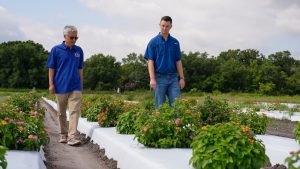A University of Florida scientist has sequenced the genome of one representative type of lantana, research that will help other plant breeders develop sterile varieties and help researchers control the plant from spreading.
“This new genome assembly (sequence) has helped us develop new tools to speed up our lantana genetic sterilization efforts and to identify native lantana for preservation,” said Zhanao Deng, a UF/IFAS professor of environmental horticulture.
Brooks Parrish, a doctoral student in Deng’s lab and the first author of the new paper, compared the genome sequence to a user’s manual.

“Imagine a genome as a giant instruction book that tells a plant how to grow, what color its flowers should be, and everything else about it,” Parrish said. “In this study, we’ve assembled and annotated a very detailed and accurate version of this instruction book for a specific type of lantana plant.”
“Other researchers can also use this instruction book to help with their work on breeding, sterilizing, conserving or controlling lantana plants,” he said. “For example, these instructions contain genes that could be targets for new herbicides to help control invasive lantana in the ecosystems.”
Some lantanas are invasive. They can form dense, impenetrable thickets that destroy native vegetation. They also can compete with other plants for resources, reducing the productivity of pastures and forests.
Sterilizing a lantana is the key to preventing it from invading natural and agricultural land or threating, endangering other plants.
“Invasive lantana can cross-pollinate with native lantana, contaminating the native lantana’s gene pool,” said Deng, who breeds ornamental plants at the Gulf Coast Research and Education Center. “In response, we have developed and released sterile, non-invasive lantana cultivars that can produce lots of attractive flowers and attractive butterflies. But they don’t cross-pollinate native lantana and don’t produce seeds.”
Deng’s commercially available lantanas are sold under the names ‘Bloomify Red,’ ‘Bloomify Rose’ and Luscious Royale® Red Zone™.
“These sterile, non-invasive cultivars are perfect alternatives to the invasive lantanas,” he said.
Additionally, Deng and his team are testing more new lantana varieties for sterility and to see how well they perform in nurseries and flower gardens.
###
ABOUT UF/IFAS
The mission of the University of Florida Institute of Food and Agricultural Sciences (UF/IFAS) is to develop knowledge relevant to agricultural, human and natural resources and to make that knowledge available to sustain and enhance the quality of human life. With more than a dozen research facilities, 67 county Extension offices, and award-winning students and faculty in the UF College of Agricultural and Life Sciences, UF/IFAS brings science-based solutions to the state’s agricultural and natural resources industries, and all Florida residents.
 2
2
